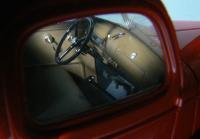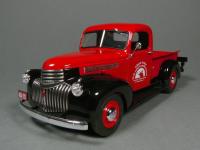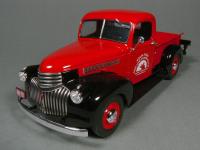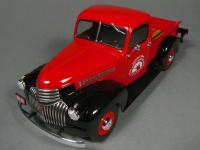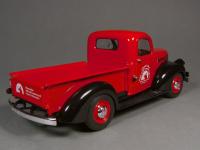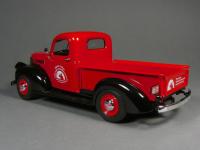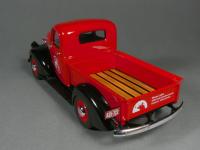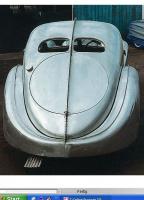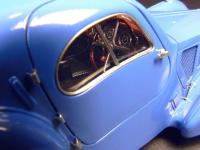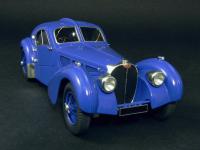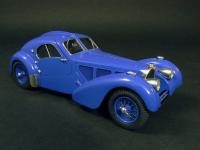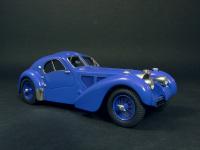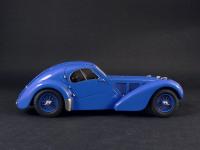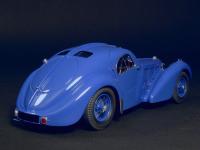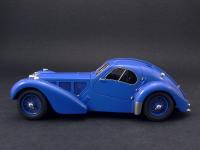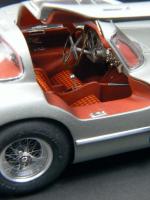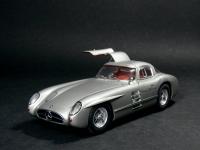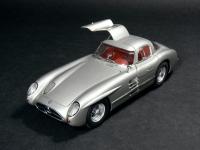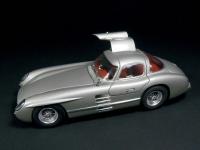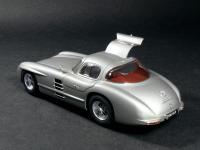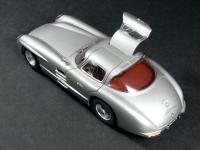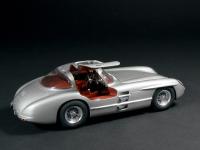-
Posts
880 -
Joined
-
Last visited
Content Type
Profiles
Forums
Events
Gallery
Everything posted by Plastheniker
-

1941 Chevrolet AK Pickup
Plastheniker replied to Plastheniker's topic in Model Trucks: Pickups, Vans, SUVs, Light Commercial
Thanks for your kind comments. I am going to show the mentioned Dodge L-700 with this Chevy on the trailer within the next weeks in the Big Rigs subforum. I hope you will be interested. -
Another perfect build - regrettably not mine ...
-
Certainly no shake-the-box kit. Perfect job!
-
Dominik, another immaculate model of yours - as usual. Your self-made decals make it really unique. The icing on the cake, however, is your ingenious diorama that really makes clear what the 1:1 vehicle was made for. One of the best jobs I have seen so far. Wirklich gut!
-
Jason, obviously you have done a great job on this model and on the Sauber as well, but it is a bit cumbersome to find out, because your pictures are very large. If you resize them to let's say 70 KB the complete vehicle (and not only parts) appears on the screen and viewers can really appreciate your work.
-

1958 Dodge Model Finished - - Class of '58 - - Entry #9
Plastheniker replied to Ramfins59's topic in Model Cars
In my opinion the late fifties brought the most attractive American cars and your models proves this with perfection. Simply fantastic! -
Hi, when I built Lindberg's Dodge L-700 as a restorer's rig I needed a "restored" load. After 55 years of modeling I started this stock 1941 Chevy as my very first pickup kit admittedly without much enthusiasm, but then I was really surprised that this kit was interesting to build and made a very attractive model. Besides some minor detailing it is OOB.
-

1937 Bugatti Atlantic 57 S - Mother of all Sports Cars?
Plastheniker replied to Plastheniker's topic in Model Cars
Matt, thanks for the fantastic link that I did not know up to now. Since I do a lot of big rig scratchbuilding I was glad to find there casted louvres in various larger sizes. All louvres I saw before were much too small for my requirements. Thanks again! -

1937 Bugatti Atlantic 57 S - Mother of all Sports Cars?
Plastheniker replied to Plastheniker's topic in Model Cars
Thanks for all further comments. Skip, Harry, Matt, I meant this item http://www.micromark.com/HO-scale-decals-with-raised-3D-rivets-and-other-surface-details,9968.html If it works as promised it would be a fantastic solution because these rivets are really 3-dimensional. Matt's idea would certainly work and give a quick and accurate result. Since these printed decal rivets are either dark grey or silver it would be interesting how the effect on various vehicle colours would be. After some pondering I am convinced that Harry's idea of using an ultra-fine Sharpie would work as well. Here the problem would be to create a straight line of "rivets" with equal distances between them. This, however, could be achieved by using a strip cut from a suitable universal PE fret (as Scale Link produces for decades) as a template. Either the position of all rivets could be marked with a pin first or the dot could be made directly. -

1937 Bugatti Atlantic 57 S - Mother of all Sports Cars?
Plastheniker replied to Plastheniker's topic in Model Cars
Skip, once again your expertise is impressive. Perhaps it might be interesting for those not familiar with the Aérolithe/Atlantic that probably one chassis(!) and one body were really made of Elektron. Aérolithe and Atlantic can be distinguished easily: Only the Aérolithe had the high and flat standard radiator and by this a higher bonnet and smaller windscreens. -

1937 Bugatti Atlantic 57 S - Mother of all Sports Cars?
Plastheniker replied to Plastheniker's topic in Model Cars
Thanks for your comments so far. Skip, Matt, the question how to replicate the rivets caused some headache without result. Remember the 1/24 scale of my model. This picture shows how tiny the rivets on the 1:1 car are. I estmated that their diameter is about 6 to 7mm, i. e. 0.25mm in 1/24. First I tried to glue on small plastic discs made with a punch and die set. Minimum diameters of purchased sets are usually 0.6mm, my self-made set allows even 0.5mm. 0.5mm dia. is extremly hard to handle, nevertheless I managed to apply a short line of rivets. It simply looked completely out of scale and resembled Nemo's Nautilus. Then I tried to apply styrene and aluminum strips embossed with a pounce wheel. This looked even worse. Last I tried the method how plane modelers restore rivets on sanded surfaces, namely by sticking a needle. This failed too, because the metal was much too hard. After some more days of pondering I gave up. Maybe today there would be a solution even without making larger fins, because recently I saw sheets with lines of tiny rivets that can be applied like decals. -
Hi, It is hard to understand why kit manufacturers ignore some of the most spectacular pacemakers of automotive history. One of these ignored vehicles is the Bugatti Atlantic. In 1937 it showed many features that we consider to be typical for a modern sports car: Breathtaking appearance and performance, a radically reduced vehicle height for a low center of gravity, doors reaching into the roof, the use of lightweight materials. Some years ago I happened to see a pile of 1/24 Bburago toy models at a large food store at less than (converted) $ 10.00. Among them were some Bugatti Atlantic. At first glance they looked rather odd but on nearer view their proportions seemed to be possibly correct. At home this first impression proved true: All dimensions of the metal body were correct. A big problem were the poorly fitting movable doors with their crude hinges. Door gaps varied extremely because firstly the door shapes were different from the door openings and secondly the doors didn't follow the curvatures of the body. The rear radiator edges "flow" into the hood of the real car. This striking feature was missing, probably it was too difficult to reproduce it for a toy model. There were no usuable interior parts. The crude chassis and all other parts were made of a strange kind of plastic. It was very hard and tough, and sanding or to gluing it turned out to be impossible. Rims and tyres had a completely wrong "universal" size. Therefore only the metal body from fire-wall to the rear (including the integrated front fenders) and the two doors were used. I stripped the paint, sanded off all details and after days of adjustment work inserted them closed. All the rest of my model had to be self-made including chassis, radiator, hood, interior, rims and tires. Only very few Atlantic were built, so all cars are slightly different. My model shows the vehicle delivered to England to R. Pope (registration EXK 6), later owned by Ralph Lauren.
-
Tommy, that is a really interesting link. By the way for those who are interested in a short overwiew this English wikipedia article might be quite useful: http://en.wikipedia.org/wiki/Mercedes-Benz_300_SLR For those who want to go into detail in my oppinion Karl Ludvigsen's book The Mercedes-Benz Racing Cars is still the standard.
-
Thanks for all further comments. Dave, this is one of the best OOB models I have seen. The door looks well-aligned and the bonnet is really closed - this is often not the case because the engine is too high or the bonnet hinge is not properly located. You achieved the best OOB result possible. Harry, you are right. The kit decals make the nice upholstery pattern. As far as I remember the decals were one of the real pros of the kit.
-
Thanks for your comments so far. Brian is absolutely right. Broken windshield posts ( "A column") are another typical shortcome of this kit. I purchased another kit because I needed it for a kitbash for a Protar W 196 GP car. Both pillars were broken. Using strips of styrene around the complete door opening for making a door stop is the only way to insert the doors properly. Otherwise they would hang half inside and half outside of the body and you could peep through the door gaps. Since the door openings are mostly curved and the result should look acceptable also from the interior, this is a real pain and very time consuming - neurasthenics should refrain.
-
Thanks for all comments so far. Perhaps I should have mentioned Revell's second classic truck. The kit of the Büssing 8000 S is as outstanding as the Krupp. Carefully built it makes an equally attractive model. I would really recommend both to everyone inclined to build them. You would be delighted!
-
Hi, certainly there would be no need to say anything about the 300SL. The 300 SLR, however, is much less known. Those not familiar with this vehicle might be interested in some basic information. In 1954 Mercedes returned to racing and dominated immediately GP (F1) racing with the W 196 and sports car racing with the technically similar 300 SLR (that open car with the spectacular air brake). For the 1956 racing season Mercedes converted two open 300 SLR into coupes for long distance racing in order to reduce the drivers' physical stress. After the Le Mans disaster, however, Mercedes decided to retire from all racing activities after the 1955 season. Therefore both coupes were never raced. Made road-legal they mainly served as personal cars of Rudolf Uhlenhaut, the head of the Mercedes racing department. He crossed Europe with both cars and covered several 10.000 kilometers. Since they turned out as incredibly reliable and durable Mercedes was urged to build a small number of vehicles as an ultimate 290 kph super car for the super rich. But despite several blanc checks Mercedes preferred to keep their technical knowledge. Both coupes still belong to the Mercedes museum. I read the other day that if ever sold each would be worth appr. € 50,000,000.00 (nearly $ 70,000,000.00). Both cars show minor differences: f. e. #1 has red interior trim and horizontal chrome moldings left and right of the Mercedes star; #2 has blue interior trim and no chrome moldings. When Revell of Germany announced the Uhlenhaut-Coupé in the early nineties this excited great expectations: a kit manufacturer with access to two museum cars only 300 kliometers away and such a fascinating subject - this had to become a fantastic kit. But instead Revell released a complete failure. While chassis and drive train go together pretty well, the body is notorious for its extremely poor fit. If your body parts are luckily not warped and you want hood and both doors open this will not show. If not (because you are not willing to spoil the breathtaking lines of the car) you have a problem. Especially the fit of the doors is so poor that it is almost impossible to build them closed, particularly as the body hasn't even a door stop. Anyway, besides the fit issues only some minor detailing was necessary. With a set of self-made wire wheels it became an acceptable model - even if today after 20 years I had some better solutions.
-

The Bill Rutan Special...a Hill Climbing VW/Porsche
Plastheniker replied to curt raitz's topic in Model Cars
Fantastic idea and flawless execution! A really unique model I would be proud of. -
Peter, what about using a set of simple, versatile and inexpensive "close-up lenses"? I use mine for about 30 years and they turned out to be an excellent investment. Every camera lense has a thread at the front end where you screw on f. e. filters. Instead of filters you can screw on the mentioned close-up lenses. They look like filters but in fact are magnifying glasses and reduce the focusing distance. They come in a large variety of magnifications (diopters). I use +1, +2 and +4 diopters. Since you can combine them you can photograph the teeth of an ant - if you like. You can use them on any camera lense from wide-angle to tele, so the possible variations and effects are endless. They are available at any camera shop. There are complete sets (however of uncertain quality) from +1 to +10 Diopters starting from € 20,00 online. You only have to consider the thread diameter of your Canon lense ( probably 52 or 55mm).
-
Thanks for all further comments! Joe, Brandon, I cannot say much about the Fujimi GTO since I don't know it very well. I can only say that all Fujimi kits that I know are good or excellent. Please be aware that there are two completely different German Revell kits of the GTO: Revell kit # 7293 was released in 1988 with this box side It is identical with the Italeri kit that I used for my model. The recently released Revell kit is an old Protar kit. You can't expect much if you hear the name Protar - but it is even worse. Judge yourself http://scaniagreifsons-modellbauforum.forenking.com/t2115-ferrari_250_gto.html
-
Gruezi Peter! I am happy to see that you also build European cars. Your BMW is as immaculate as all your other models that I have seen here. I think I know why you live in Switzerland. You preserve your models in a Swiss bank safe, don't you?
-
An unusual subject, outstanding workmanship and great pictures. Excellent job!
-
Hi, whoever in Germany has any interest in trucks knows the Krupp Titan - even more than six decades after its introduction in 1950. The few Titans that still exist are the highlight of every vintage truck meeting. Some features made the Titan unique in those early post-war years: Because Krupp had no big engine they coupled two 3-cylinder two-stroke diesel engines. Krupp was the only German manufacturer that ever used two-stroke diesels. The idling sound was so odd that the Titan was known as the only truck that was able to say its name ("kruppkruppkruppkruppkrupp...") Its power of 210 PS was incredible, most other German heavy trucks had only 130 to 160 PS ( 1 PS = appr. 1hp net). Additionally there was a high-speed version available that was capable of 94 kph, faster than many of the small passenger cars in those days. Its appearance - obviously inspired by the Cord 812 and the 1937 Opel Kapitän - was spectacular. I still remember that I saw one as a boy of about five years. I was so fascinated that I urged my father for days until he bought me a Titan as a toy model. There is not much to say about the Revell kits: They are outstanding, probably the best kits ever made by Revell of Germany. Except a minor fit problem between fenders and cab they are a pleasure to build. Unfortunately Revell recommends really unattractive colour combinations. Therefore I finished my models 10 or 15 years ago in those colours I saw as a little boy. A similar topic of mine: 1937 Mercedes-Benz L 10000 Scratchbuilt 1/24 http://www.modelcarsmag.com/forums/index.php?showtopic=75830
-
Thanks for all further comments. Bill, yesterday I overlooked one model because it stood on my photo table. Its tyres should fit. It is the Academy Ferrari 250 LM. The 1:1 car had 5.50 x 15 front and 7.00 x 15 rear. The model tyres are only a bit wider than that. They look quite acceptable, the sidewalls are blank. As far as I know the kit is not available for some time, but should be found online. I hope this will help if necessary.
-

Mercedes W154 M163 - Grand Prix Champion 1939 1/20
Plastheniker replied to Plastheniker's topic in Model Cars
Thanks for your comments. I admit that I am a bit surprised that there is so little interest in one of the milestones of racing history. But I don't care , I have a thick skin. For the few GP connoisseurs I will go on. My next pair will be the 1951 Alfa Romeo Tipo 159 Alfetta. I hope you will be interested again.

